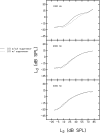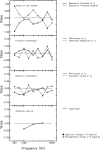Sources of variability in distortion product otoacoustic emissions
- PMID: 18681596
- PMCID: PMC2561309
- DOI: 10.1121/1.2939126
Sources of variability in distortion product otoacoustic emissions
Abstract
The goal of this study was to determine the extent to which the variability seen in distortion product otoacoustic emissions (DPOAEs), among ears with normal hearing, could be accounted for. Several factors were selected for investigation, including behavioral threshold, differences in middle-ear transmission characteristics either in the forward or the reverse direction, and differences in contributions from the distortion and reflection sources. These variables were assessed after optimizing stimulus parameters for individual ears at each frequency. A multiple-linear regression was performed to identify whether the selected variables, either individually or in combination, explained significant portions of variability in DPOAE responses. Behavioral threshold at the f(2) frequency and behavioral threshold squared at that same frequency explained the largest amount of variability in DPOAE level, compared to the other variables. The combined model explained a small, but significant, amount of variance in DPOAE level at five frequencies. A large amount of residual variability remained, even at frequencies where the model accounted for significant amounts of variance.
Figures









References
-
- Dhar, S. and Shaffer, L. (2004). “Effects of a suppressor tone on distortion product otoacoustic emissions fine structure: Why a universal suppressor level is not a practical solution to obtaining single-generator DP-grams,” Ear Hear. EAHEDS10.1097/00003446-200412000-00006 25, 573–585. - DOI - PubMed
Publication types
MeSH terms
Grants and funding
LinkOut - more resources
Full Text Sources
Miscellaneous

